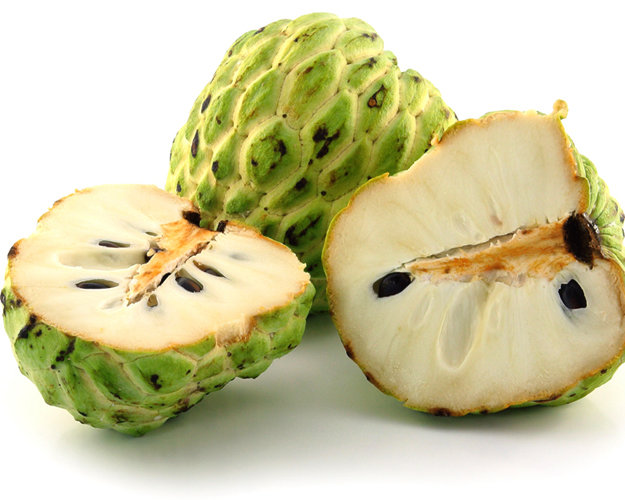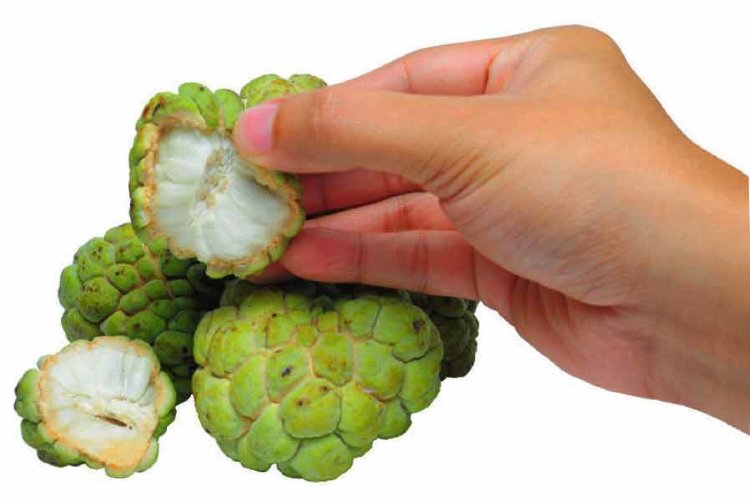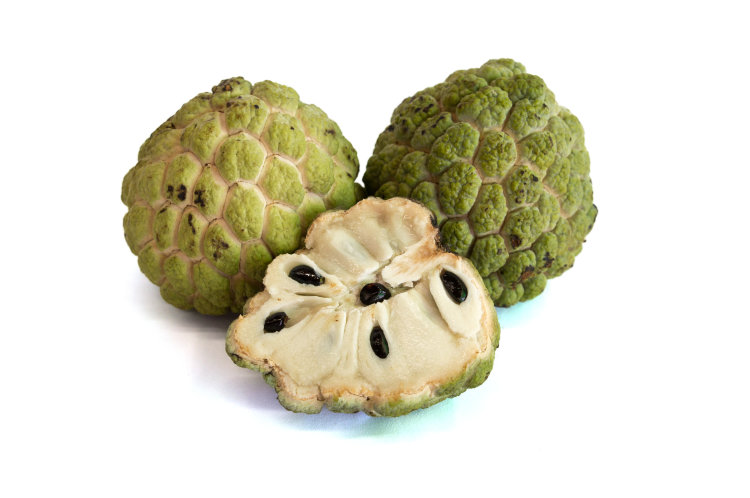- Overview
Common name: Sugar Apple, Sweetsop, Anon Botanical name: Annona squamosa Family: Annonaceae Origin: Tropical America Avg. Height X Width: 15' x 10' Season: August - November Damage temp: 28 F Sugar Apple Tree in a 3 Gallon Container. The sugar apple is an exquisite fruit that is very closely related to the cherimoya. The fruit are typically baseball to softball size, and they taste like sugary sweet custard. The pulp comes apart in segments each containing a small black seed that separates easily from the fruit. The trees begin to fruit at just one to two years of age, and they can easily be maintained at eight to ten feet for container growing in colder climates. Fruit are extremely sweet and taste like a sugary custard.
Description
Origin and Distribution
Cultivars
Climate
Soil
Propagation
Culture
Cropping and Yield
Keeping Quality
Pests and Diseases
Food Uses
Toxicity
Other Uses
Medicinal Uses
Food ValueThe most widely grown of all the species of Annona, the sugar apple, A. squamosa L., has acquired various regional names: anon (Bolivia, Costa Rica, Cuba, Panama); anon de azucar, anon domestico, hanon, mocuyo (Colombia); anona blanca (Honduras, Guatemala, Dominican Republic); anona de castilla (El Salvador); anona de Guatemala (Nicaragua); applebush (Grenadines); ata, fruta do conde, fruta de condessa, frutiera deconde, pinha, araticutitaia, or ati (Brazil); ates or atis (Philippines); atte (Gabon); chirimoya (Guatemala, Ecuador); cachiman (Argentina); cachiman cannelle (Haiti); kaneelappel (Surinam); pomme cannelle (Guadeloupe, French Guiana, French West Africa); rinon (Venezuela); saramulla, saramuya, ahate (Mexico); scopappel (Netherlands Antilles); sweetsop (Jamaica, Bahamas); ata, luna, meba, sharifa, sarifa, sitaphal, sita pandu, custard apple, scaly custard apple (India); bnah nona, nona, seri kaya (Malaya) manonah, noinah, pomme cannelle du Cap (Thailand); qu a na (Vietnam); mang cau ta (Cambodia); mak khbieb (Laos); fan-li-chi (China).
The sugar apple tree ranges from 10 to 20 ft (3-6 m) in height with open crown of irregular branches, and some-what zigzag twigs. Deciduous leaves, alternately arranged on short, hairy petioles, are lanceolate or oblong, blunt tipped, 2 to 6 in (5-15 cm) long and 3/4 to 2 in (2-5 cm) wide; dull-green on the upperside, pale, with a bloom, below; slightly hairy when young; aromatic when crushed. Along the branch tips, opposite the leaves, the fragrant flowers are borne singly or in groups of 2 to 4. They are oblong, 1 to 1 1/2 in (2.5-3.8 cm) long, never fully open; with 1 in (2.5 cm) long, drooping stalks, and 3 fleshy outer petals, yellow-green on the outside and pale-yellow inside with a purple or dark-red spot at the base. The 3 inner petals are merely tiny scales. The compound fruit is nearly round, ovoid, or conical; 2 1/3 to 4 in (6-10 cm) long; its thick rind composed of knobby segments, pale-green, gray-green, bluish-green, or, in one form, dull, deep-pink externally (nearly always with a bloom); separating when the fruit is ripe and revealing the mass of conically segmented, creamy-white, glistening, delightfully fragrant, juicy, sweet, delicious flesh. Many of the segments enclose a single oblong-cylindric, black or dark-brown seed about 1/2 in (1.25 cm) long. There may be a total of 20 to 38, or perhaps more, seeds in the average fruit. Some trees, however, bear seedless fruits.
Origin and Distribution
The original home of the sugar apple is unknown. It is commonly cultivated in tropical South America, not often in Central America, very frequently in southern Mexico, the West Indies, Bahamas and Bermuda, and occasionally in southern Florida. In Jamaica, Puerto Rico, Barbados, and in dry regions of North Queensland, Australia, it has escaped from cultivation and is found wild in pastures, forests and along roadsides. The Spaniards probably carried seeds from the New World to the Philippines and the Portuguese are assumed to have introduced the sugar apple to southern India before 1590. It was growing in Indonesia early in the 17 th century and has been widely adopted in southern China, Queensland, Australia, Polynesia, Hawaii, tropical Africa, Egypt and the lowlands of Palestine. Cultivation is most extensive in India where the tree is also very common as an escape and the fruit exceedingly popular and abundant in markets. The sugar apple is one of the most important fruits in the interior of Brazil and is conspicuous in the markets of Bahia.
Cultivars
The 'Seedless Cuban' sugar apple was introduced into Florida in 1955, has produced scant crops of slightly malformed fruits with mere vestiges of undeveloped seeds. The flavor is less appealing than that of normal fruits but it is vegetatively propagated and distributed as a novelty. Another seedless type was introduced from Brazil. Indian horticulturists have studied the diverse wild and cultivated sugar apples of that country and recognize ten different types: 'Red' (A. squamosa var. Sangareddyiz)—red-tinted foliage and flowers, deep-pink rind, mostly non-reducing sugars, insipid, with small, blackish-pink seeds; poor quality; comes true from seed. 'Red-speckled'—having red spots on green rind. 'Crimson'—conspicuous red-toned foliage and flowers, deep-pink rind, pink flesh. 'Yellow'; 'White-stemmed'; 'Mammoth' (A. squamosa var. mammoth)—pale yellow petals, smooth, broad, thick, round rind segments that are light russet green; fruits lopsided, pulp soft, white, very sweet; comes true from seed. 'Balangar'—large, with green rind having rough, warty [tuberculate], fairly thick rind segments with creamy margins; sweet; high yielding. 'Kakarlapahad'—very high yielding. 'Washington'—acute tuberculate rind segments, orange-yellow margins; high yielding; late in season, 20 days after others. 'Barbados' and 'British Guiana'—having green rind, orange-yellow margins; high-yielding; late. Named cultivars growing at the Sabahia Experiment Station, Alexandria, Egypt, include: 'Beni Mazar'—nearly round, large, 5 1/4 to 6 1/2 oz (150-180 g); 56-60% flesh; 15 30 seeds. 'Abd El Razik'—light-green or reddish rind; nearly round, large, maximum 8 1/3 oz (236.3 g); 69.5% flesh; 14 seeds.
Climate
The sugar apple tree requires a tropical or near-tropical climate. It does not succeed in California because of the cool winters though in Israel it has survived several degrees below freezing. Generally, it does best in dry areas and it has high drought tolerance. However, in Ceylon it flourishes in the wet as well as the dry zones from sea level to 3,500 ft (1,066 m) elevation. During the blooming season, drought interferes with pollination and it is, therefore, concluded that the sugar apple should have high atmospheric humidity but no rain when flowering. In severe droughts, the tree sheds its leaves and the fruit rind hardens and will split with the advent of rain.
Soil
The sugar apple is not particular as to soil and has performed well on sand, oolitic limestone and heavy loam with good drainage. Water-logging is intolerable. The tree is shallow-rooted and doesn't need deep soil. Irrigation water containing over 300 ppm chlorine has done the tree no harm.
Propagation
Sugar apple seeds have a relatively long life, having kept well for 3 to 4 years. They germinate better a week after removal from the fruit than when perfectly fresh. Germination may take 30 days or more but can be hastened by soaking for 3 days or by scarifying. The percentage of germination is said to be better in unsoaked seeds. While the tree is generally grown from seed, vegetative propagation is practiced where the crop is important and early fruiting is a distinct advantage. Seedlings may be budded or grafted when one-year old. In India, selected clones grafted on A. reticulata seedlings have flowered within 4 months and fruited in 8 months after planting out, compared with 2 to 4 years in seedlings. The grafted trees are vigorous, the fruits less seedy and more uniform in size. A. senegalensis is employed as a rootstock in Egypt. A. glabra is suitable but less hardy. The sugar apple itself ranks next after A. reticulata as a rootstock. In India, budding is best done in January, March and June. Results are poor if done inJuly, August, November or December unless the scions are defoliated and debudded in advance and cut only after the petioles have dehisced. Side-grafting can be done only from December to May, requires much skill and the rate of success has not exceeded 58.33%. Shield-budding gives 75% success and is the only commercially feasible method. Inarching is 100% successful. Cuttings, layers, airlayers have a low rate of success, and trees grown by these techniques have shallow root systems and cannot endure drought as well as seedlings do.
Culture
In Egypt, sugar apple trees are spaced at 10 x 10 ft (3x3 m) in order to elevate atmospheric humidity and improve pollination. Palestinian growers were spacing at 16 x 16 ft (5x5 m) but changed to 16 x 10 ft (5x3 m) as more feasible. On light soils, they apply 132 to 176 lbs (60-80 kg) manure per tree annually and they recommend the addition of nitrogen. Commercial fertilizer containing 3% N, 10 % P and 10% K significantly increases flowering, fruit set and yield. Judicious pruning to improve shape and strength of tree must be done only in spring when the sap is rising, otherwise pruning may kill the tree. Irrigation during the dry season and once during ripening will increase fruit size.
Cropping and Yield
Seedlings 5 years old may yield 50 fruits per tree in late summer and fall. Older trees rarely exceed 100 fruits per tree unless hand-pollinated. With age, the fruits become smaller and it is considered best to replace the trees after 10 to 20 years. The fruits will not ripen but just turn black and dry if picked before the white, yellowish or red tint appears between the rind segments, the first signs of separation. If allowed to ripen on the tree, the fruit falls apart.
Keeping Quality
In India, mature fruits treated with 50-60 g carbide ripened in 2 days and thereafter remained in good condition only 2 days at room temperature, while those packed in straw ripened in 5-6 days and kept well for 4 days. Storage trials in Malaya indicate that the ripening of sugar apples can be delayed by storage at temperatures between 59° and 68°F (15°-20°C) and 85-90% relative humidity, with low O2 and C2 H2. To speed ripening at the same temperature and relative humidity, levels of O2 and CO2 should be high. Storing at 39.2°F (4°C) for 5 days resulted in chilling injury. In Egypt, of 'Beni Mazar' fruits, picked when fullgrown, ll5 days from set, and held at room temperature, 86°,to ripened in 10 days. Of 'Abd E1 Razik' fruits, 140 days from set, 56% were ripe in 15 days. Therefore, 'Abd E1 Razik' is better adapted to Upper Egypt where the climate should promote normal ripening.
Pests and Diseases
In Florida and the Caribbean, a seed borer (chalcid fly), Bephratelloides cubensis, infests the seeds and an associated fungus mummifies the partly grown fruits on the tree. This has discouraged many from growing the sugar apple, though in the past it was a fairly common dooryard fruit tree. Similar damage is caused by B. maculicollis in Colombia, Venezuela and Surinam, by B. ruficollis in Panama, and B. paraguayensis in Paraguay. The soft scale, Philephedra sp., attacks leaves and twigs and deposits honeydew on which sooty mold develops. Ambrosia beetles lay eggs on young stems and the larvae induce dieback during the winter. The mealybug is the main pest in Queensland, Australia, but is easily controlled. The green tree ant is a nuisance because of the nests it makes in the tree. Bird and animal predators force Indian growers to cover the tree with netting or pick the fruits prematurely and ripen them in straw. A serious leaf blight in India is caused by the fungus Colletotrichum annonicola. In 1978 a new fruit rot of sugar apple was observed in India, beginning with discoloration at one end which turns brown or black in 4 or 5 days, and 2 or 3 days later the entire fruit starts to rot. Later, the fruit is covered with gray-black mycelium and spherical bodies. The isolated fungus was identified as the Colletotrichum state of Glomerella cingulata.The ripe sugar apple is usually broken open and the flesh segments enjoyed while the hard seeds are separated in the mouth and spat out. It is so luscious that it is well worth the trouble. In Malaya, the flesh is pressed through a sieve to eliminate the seeds and is then added to ice cream or blended with milk to make a cool beverage. It is never cooked.
Toxicity
The seeds are acrid and poisonous. Bark, leaves and seeds contain the alkaloid, anonaine. Six other aporphine alkaloids have been isolated from the leaves and stems: corydine, roemerine, norcorydine, norisocarydine, isocorydine and glaucine. Aporphine, norlaureline and dienone may be present also. Powdered seeds, also pounded dried fruits serve as fish poison and insecticides in India. A paste of the seed powder has been applied to the head to kill lice but must be kept away from the eyes as it is highly irritant and can cause blindness. If applied to the uterus, it induces abortion. Heat-extracted oil from the seeds has been employed against agricultural pests. Studies have shown the ether extract of the seeds to have no residual toxicity after 2 days. High concentrations are potent for 2 days and weaken steadily, all activity being lost after 8 days. In Mexico, the leaves are rubbed on floors and put in hen's nests to repel lice.
Other Uses
The seed kernels contain 14-49% of whitish or yellowish, non-drying oil with saponification index of 186.40. It has been proposed as a substitute for peanut oil in the manufacture of soap and can be detoxified by an alkali treatment and used for edible purposes. The leaves yield an excellent oil rich in terpenes and sesquiterpenes, mainly B-caryophyllene, which finds limited use in perfumes, giving a woody spicy accent. Fiber extracted from the bark has been employed for cordage. The tree serves as host for lac-excreting insects.
Medicinal Uses
In India the crushed leaves are sniffed to overcome hysteria and fainting spells; they are also applied on ulcers and wounds and a leaf decoction is taken in cases of dysentery. Throughout tropical America, a decoction of the leaves alone or with those of other plants is imbibed either as an emmenagogue, febrifuge, tonic, cold remedy, digestive, or to clarify the urine. The leaf decoction is also employed in baths to alleviate rheumatic pain. The green fruit, very astringent, is employed against diarrhea in El Salvador. In India, the crushed ripe fruit, mixed with salt, is applied on tumors. The bark and roots are both highly astringent. The bark decoction is given as a tonic and to halt diarrhea. The root, because of its strong purgative action, is administered as a drastic treatment for dysentery and other ailments.
Food Value Per 100 g of Edible Portion *
Calories 88.9-95.7 g
Moisture 69.8-75.18 g
Fat 0.26-1.10 g
Carbohydrates** 19.16-25.19 g
Crude Fiber 1.14-2.50 g
Protein 1.53-2.38 g
Amino Acids: Tryptophan 9-10 mg
Methionine 7-8 mg
Lysine 54-69 mg
Minerals: Ash 0.55-1.34 mg
Phosphorus 23.6-55.3 mg
Calcium 19.4-44.7 mg
Iron 0.28-1.34 mg
Vitamins: Carotene 5-7 I.U.
Thiamine 0.100-0.13 mg
Riboflavin 0.113-0.167 mg
Niacin 0.654-0.931 mg
Ascorbic Acid 34.7-42.2 mg
*Minimum and maximum levels of constituents from analyses made in the Philippines, Central America and Cuba.
**The average sugar content is 14.58% and is about 50-50 glucose and sucrose. - Features
weight: 9.99 lbs : - Reviews1








I received this plant almost 2 months ago, was surprised plant came in a big box and it was in pot as promised and the plant was a little over 5 feet tall.Some leaves do fall in shipping but plant is still looking healthy.Will not hesitate in ordering more plants from them. Thanks for excellent packaging and shipping.